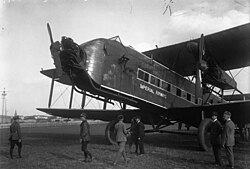Armstrong Whitworth Argosy
- For the 1950s transport, see Armstrong Whitworth AW.660 Argosy
| Argosy | |
|---|---|

| |
| An Argosy Mk I of Imperial Airways in 1926. This particular aircraft (G-EBLF) bore the name City of Glasgow. | |
| Role | Airliner |
| Manufacturer | Armstrong Whitworth |
| First flight | March 1926 |
| Primary user | Imperial Airways |
| Number built | 7 |
The Armstrong Whitworth Argosy was a British three-engine biplane airliner built by Armstrong Whitworth Aircraft, and operated by Imperial Airways from 1926 to 1935.
Development
The Armstrong Whitworth A.W.154 Argosy stemmed from a declaration by Imperial Airways that all its aircraft would be multi-engine designs, on the grounds of safety.[1] They were intended to replace the older single-engine de Havilland aircraft that Imperial Airways had inherited from its constituent companies, mainly Daimler Airway. The first example (G-EBLF) flew in March 1926,[2] following an initial order for three Argosys from Imperial Airways. An improved Mk. II version was introduced in 1929.

Operational history
The Argosy was initially used on European routes (later operating on services to South Africa), with the fleet named after cities. The first passenger flight was from London to Paris on 16 July 1926. Argosies implemented the world's first named air service, the luxury 'Silver Wing' service from London to Paris,[3] using Argosy City of Birmingham (G-EBLO). Two seats were removed and replaced with a bar, and a steward was in attendance. In April 1931 Edward, Prince of Wales and his brother Prince George flew home from Paris–Le Bourget Airport in City of Glasgow (G-EBLF), which landed specially in Windsor Great Park.[4][5]
Three Argosys were lost during service with Imperial Airways, one being written off in a forced landing near Aswan, and one during a training accident, both in 1931, with no injuries in either accident. On 28 March 1933, however, the City of Liverpool caught fire over Belgium, causing a crash in which all three crew and twelve passengers were killed.[2]
Argosys continued in service with Imperial Airways until 1935, with the last example, City of Manchester (G-AACJ), being used for joy-riding by United Airways Ltd of Stanley Park Aerodrome (Blackpool), which later was merged into British Airways Ltd. It continued in use with British Airways until December 1936.
Variants
- Argosy Mk I :Three-engined airliner. Powered by three 385 hp (287 kW) Armstrong Siddeley Jaguar IIIA radial piston engines. Later fitted with Jaguar IVA engines. Three constructed.
- Argosy Mk II :Three-engined airliner. Powered by three 420 hp (313 kW) Armstrong Siddeley Jaguar IVA radial piston engines. Four constructed.
Operators
Imperial Airways Argosy fleet 1926-1935
| Type | Registration | Name |
|---|---|---|
| Mk. I | G-EBLF | City of Glasgow |
| Mk. I | G-EBLO | City of Birmingham |
| Mk. I | G-EBOZ | City of Wellington |
| Mk. II | G-AACH | City of Edinburgh |
| Mk. II | G-AACI | City of Liverpool |
| Mk. II | G-AACJ | City of Manchester |
| Mk. II | G-AAEJ | City of Coventry |
Specifications (Argosy II)

Data from British Civil Aircraft since 1919.[6]
General characteristics
- Crew: 2
- Capacity: 20
Performance
See also
Related development
Aircraft of comparable role, configuration, and era
- Armstrong Whitworth Atalanta
- Armstrong Whitworth Ensign
- de Havilland DH.34
- de Havilland Hercules
- de Havilland Albatross
- Vickers Vulcan
Related lists
References
- Notes
- ^ Jackson 1973, p. 49
- ^ a b Donald 1997, p. 63
- ^ Taylor 1980
- ^ "Arrival at Windsor by Air". The Straits Times. 30 April 1931. Retrieved 18 December 2013.
- ^ "Princes Home". The Advertiser and Register. 1 May 1931. Retrieved 18 December 2013.
- ^ Jackson 1973, p. 51
- Bibliography
- Donald, David, ed. (1997). The Encyclopedia of World Aircraft. Aerospace Publishing. ISBN 1-85605-375-X.
{{cite book}}: Invalid|ref=harv(help) - Jackson, A.J (1973). British Civil Aircraft since 1919 Volume 1 (2nd ed.). Putnam & Co. ISBN 0-370-10006-9.
{{cite book}}: Invalid|ref=harv(help) - Mondey, David, ed. (1978). The Complete Illustrated Encyclopedia of the World's Aircraft: Military and Civil Aviation From the Beginnings to the Present Day. Secaucus, NJ: Chartwell Books Inc. ISBN 0-89009-771-2.
{{cite book}}: Invalid|ref=harv(help) - Taylor, M J H, ed. (1980). Jane's Encyclopedia of Aircraft. Jane's Publishing Company.
{{cite book}}: Invalid|ref=harv(help)
